2020LAW Crime 1 Court Project: Supreme Court Murder Trial Analysis
VerifiedAdded on 2023/01/12
|9
|2635
|73
Report
AI Summary
This report provides an analysis of a murder case, focusing on the trial of Rodney Wayne Williams in the Supreme Court of Queensland. The case involves the disappearance of Tiffany Taylor and explores the legal arguments, evidence presented, and the court's ultimate decision. The report utilizes the IRAC method to discuss the issues, relevant rules and laws (including the Criminal Code 1899), the application of these laws to the facts, and the final conclusion. The analysis examines the roles of various parties, the evidence presented (including forensic reports and witness testimonies), and the applicable legal principles of murder, manslaughter, and sexual offenses. The report highlights the lack of conclusive evidence to convict Mr. Williams, emphasizing the importance of intent and the challenges in proving guilt beyond a reasonable doubt. The conclusion reflects on the complexities of the case and the limitations of the evidence, leading to the conclusion that the court could not find Mr. Williams guilty.

Crime 1 Court Project
Paraphrase This Document
Need a fresh take? Get an instant paraphrase of this document with our AI Paraphraser
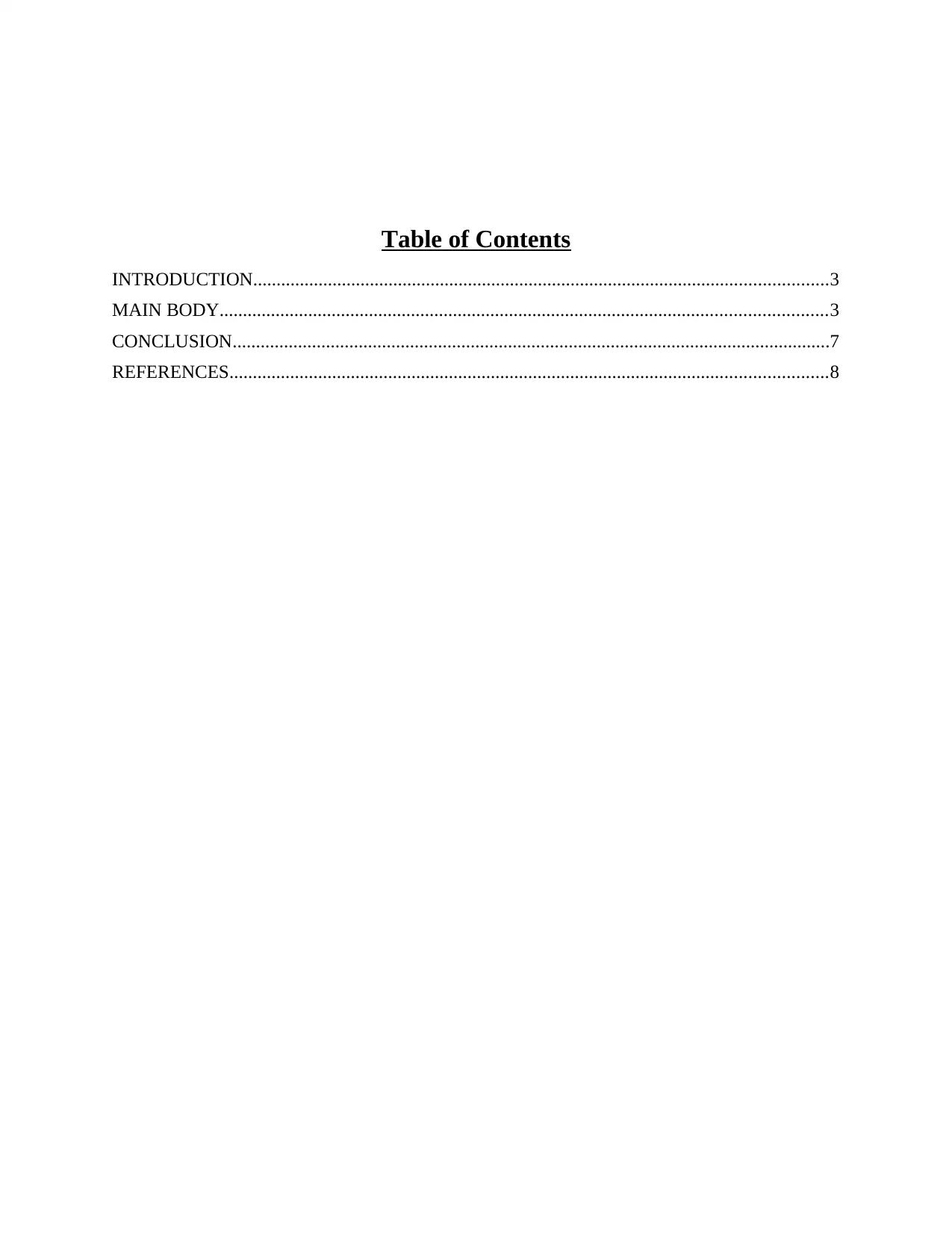
Table of Contents
INTRODUCTION...........................................................................................................................3
MAIN BODY..................................................................................................................................3
CONCLUSION................................................................................................................................7
REFERENCES................................................................................................................................8
INTRODUCTION...........................................................................................................................3
MAIN BODY..................................................................................................................................3
CONCLUSION................................................................................................................................7
REFERENCES................................................................................................................................8
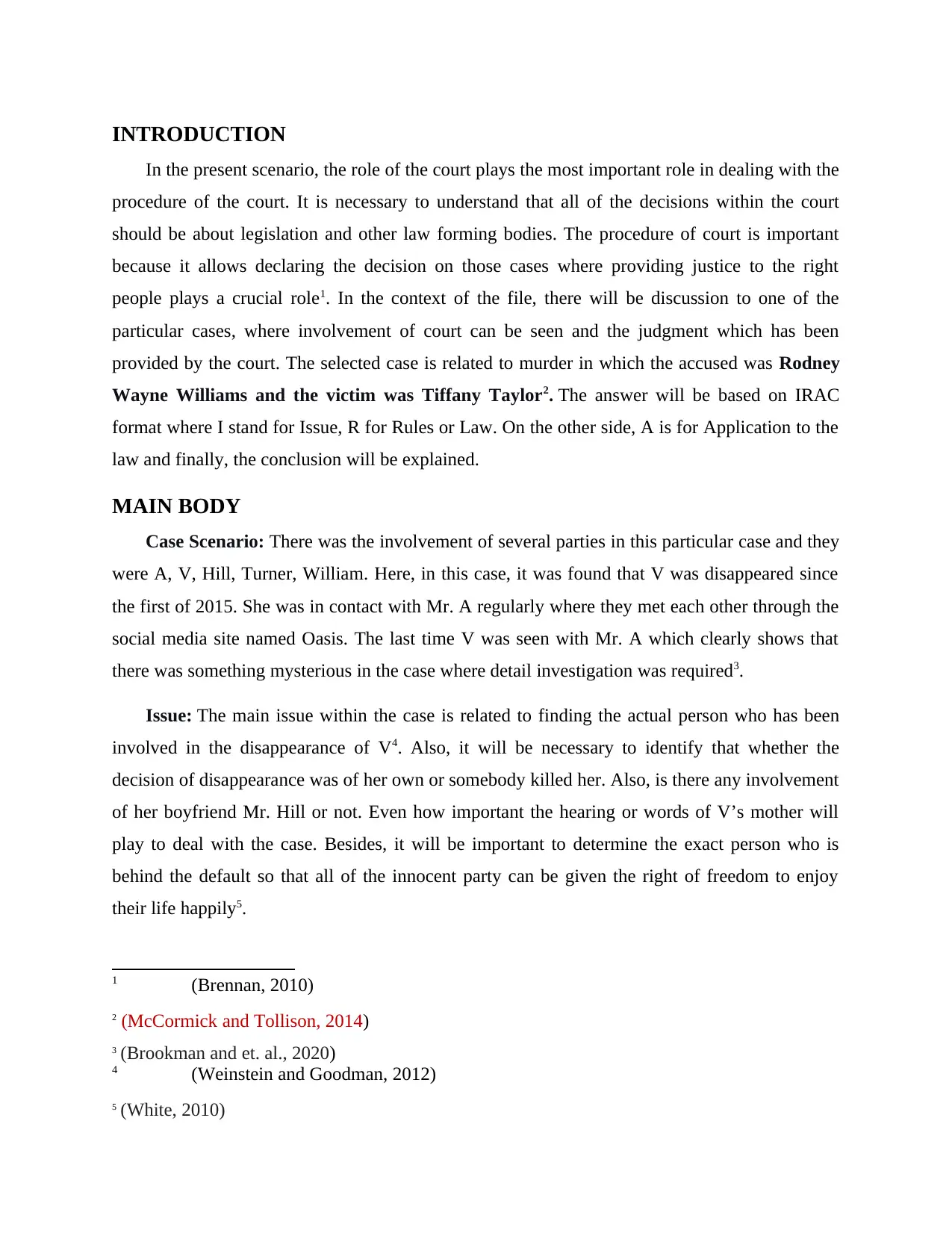
INTRODUCTION
In the present scenario, the role of the court plays the most important role in dealing with the
procedure of the court. It is necessary to understand that all of the decisions within the court
should be about legislation and other law forming bodies. The procedure of court is important
because it allows declaring the decision on those cases where providing justice to the right
people plays a crucial role1. In the context of the file, there will be discussion to one of the
particular cases, where involvement of court can be seen and the judgment which has been
provided by the court. The selected case is related to murder in which the accused was Rodney
Wayne Williams and the victim was Tiffany Taylor2. The answer will be based on IRAC
format where I stand for Issue, R for Rules or Law. On the other side, A is for Application to the
law and finally, the conclusion will be explained.
MAIN BODY
Case Scenario: There was the involvement of several parties in this particular case and they
were A, V, Hill, Turner, William. Here, in this case, it was found that V was disappeared since
the first of 2015. She was in contact with Mr. A regularly where they met each other through the
social media site named Oasis. The last time V was seen with Mr. A which clearly shows that
there was something mysterious in the case where detail investigation was required3.
Issue: The main issue within the case is related to finding the actual person who has been
involved in the disappearance of V4. Also, it will be necessary to identify that whether the
decision of disappearance was of her own or somebody killed her. Also, is there any involvement
of her boyfriend Mr. Hill or not. Even how important the hearing or words of V’s mother will
play to deal with the case. Besides, it will be important to determine the exact person who is
behind the default so that all of the innocent party can be given the right of freedom to enjoy
their life happily5.
1 (Brennan, 2010)
2 (McCormick and Tollison, 2014)
3 (Brookman and et. al., 2020)
4 (Weinstein and Goodman, 2012)
5 (White, 2010)
In the present scenario, the role of the court plays the most important role in dealing with the
procedure of the court. It is necessary to understand that all of the decisions within the court
should be about legislation and other law forming bodies. The procedure of court is important
because it allows declaring the decision on those cases where providing justice to the right
people plays a crucial role1. In the context of the file, there will be discussion to one of the
particular cases, where involvement of court can be seen and the judgment which has been
provided by the court. The selected case is related to murder in which the accused was Rodney
Wayne Williams and the victim was Tiffany Taylor2. The answer will be based on IRAC
format where I stand for Issue, R for Rules or Law. On the other side, A is for Application to the
law and finally, the conclusion will be explained.
MAIN BODY
Case Scenario: There was the involvement of several parties in this particular case and they
were A, V, Hill, Turner, William. Here, in this case, it was found that V was disappeared since
the first of 2015. She was in contact with Mr. A regularly where they met each other through the
social media site named Oasis. The last time V was seen with Mr. A which clearly shows that
there was something mysterious in the case where detail investigation was required3.
Issue: The main issue within the case is related to finding the actual person who has been
involved in the disappearance of V4. Also, it will be necessary to identify that whether the
decision of disappearance was of her own or somebody killed her. Also, is there any involvement
of her boyfriend Mr. Hill or not. Even how important the hearing or words of V’s mother will
play to deal with the case. Besides, it will be important to determine the exact person who is
behind the default so that all of the innocent party can be given the right of freedom to enjoy
their life happily5.
1 (Brennan, 2010)
2 (McCormick and Tollison, 2014)
3 (Brookman and et. al., 2020)
4 (Weinstein and Goodman, 2012)
5 (White, 2010)
⊘ This is a preview!⊘
Do you want full access?
Subscribe today to unlock all pages.

Trusted by 1+ million students worldwide
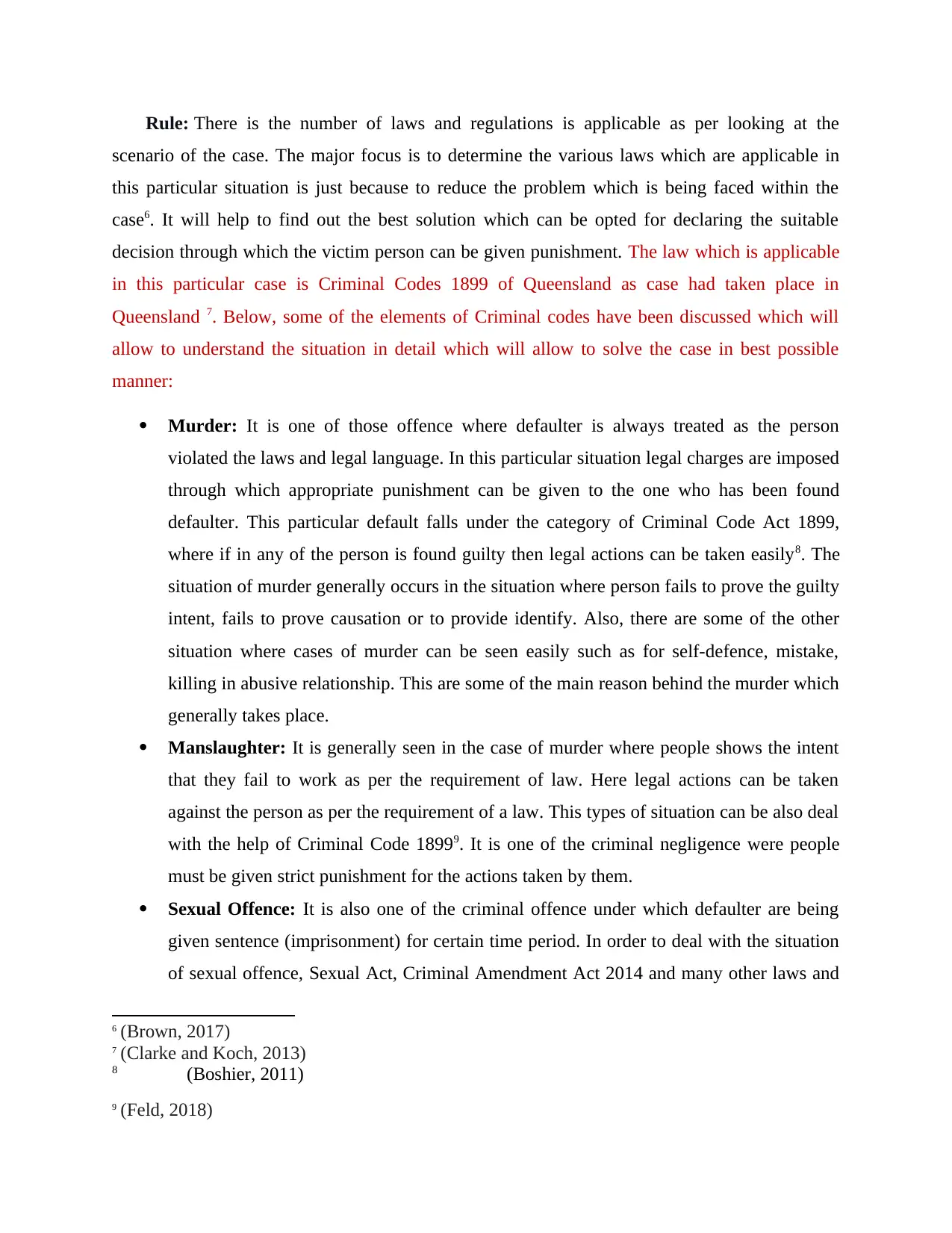
Rule: There is the number of laws and regulations is applicable as per looking at the
scenario of the case. The major focus is to determine the various laws which are applicable in
this particular situation is just because to reduce the problem which is being faced within the
case6. It will help to find out the best solution which can be opted for declaring the suitable
decision through which the victim person can be given punishment. The law which is applicable
in this particular case is Criminal Codes 1899 of Queensland as case had taken place in
Queensland 7. Below, some of the elements of Criminal codes have been discussed which will
allow to understand the situation in detail which will allow to solve the case in best possible
manner:
Murder: It is one of those offence where defaulter is always treated as the person
violated the laws and legal language. In this particular situation legal charges are imposed
through which appropriate punishment can be given to the one who has been found
defaulter. This particular default falls under the category of Criminal Code Act 1899,
where if in any of the person is found guilty then legal actions can be taken easily8. The
situation of murder generally occurs in the situation where person fails to prove the guilty
intent, fails to prove causation or to provide identify. Also, there are some of the other
situation where cases of murder can be seen easily such as for self-defence, mistake,
killing in abusive relationship. This are some of the main reason behind the murder which
generally takes place.
Manslaughter: It is generally seen in the case of murder where people shows the intent
that they fail to work as per the requirement of law. Here legal actions can be taken
against the person as per the requirement of a law. This types of situation can be also deal
with the help of Criminal Code 18999. It is one of the criminal negligence were people
must be given strict punishment for the actions taken by them.
Sexual Offence: It is also one of the criminal offence under which defaulter are being
given sentence (imprisonment) for certain time period. In order to deal with the situation
of sexual offence, Sexual Act, Criminal Amendment Act 2014 and many other laws and
6 (Brown, 2017)
7 (Clarke and Koch, 2013)
8 (Boshier, 2011)
9 (Feld, 2018)
scenario of the case. The major focus is to determine the various laws which are applicable in
this particular situation is just because to reduce the problem which is being faced within the
case6. It will help to find out the best solution which can be opted for declaring the suitable
decision through which the victim person can be given punishment. The law which is applicable
in this particular case is Criminal Codes 1899 of Queensland as case had taken place in
Queensland 7. Below, some of the elements of Criminal codes have been discussed which will
allow to understand the situation in detail which will allow to solve the case in best possible
manner:
Murder: It is one of those offence where defaulter is always treated as the person
violated the laws and legal language. In this particular situation legal charges are imposed
through which appropriate punishment can be given to the one who has been found
defaulter. This particular default falls under the category of Criminal Code Act 1899,
where if in any of the person is found guilty then legal actions can be taken easily8. The
situation of murder generally occurs in the situation where person fails to prove the guilty
intent, fails to prove causation or to provide identify. Also, there are some of the other
situation where cases of murder can be seen easily such as for self-defence, mistake,
killing in abusive relationship. This are some of the main reason behind the murder which
generally takes place.
Manslaughter: It is generally seen in the case of murder where people shows the intent
that they fail to work as per the requirement of law. Here legal actions can be taken
against the person as per the requirement of a law. This types of situation can be also deal
with the help of Criminal Code 18999. It is one of the criminal negligence were people
must be given strict punishment for the actions taken by them.
Sexual Offence: It is also one of the criminal offence under which defaulter are being
given sentence (imprisonment) for certain time period. In order to deal with the situation
of sexual offence, Sexual Act, Criminal Amendment Act 2014 and many other laws and
6 (Brown, 2017)
7 (Clarke and Koch, 2013)
8 (Boshier, 2011)
9 (Feld, 2018)
Paraphrase This Document
Need a fresh take? Get an instant paraphrase of this document with our AI Paraphraser
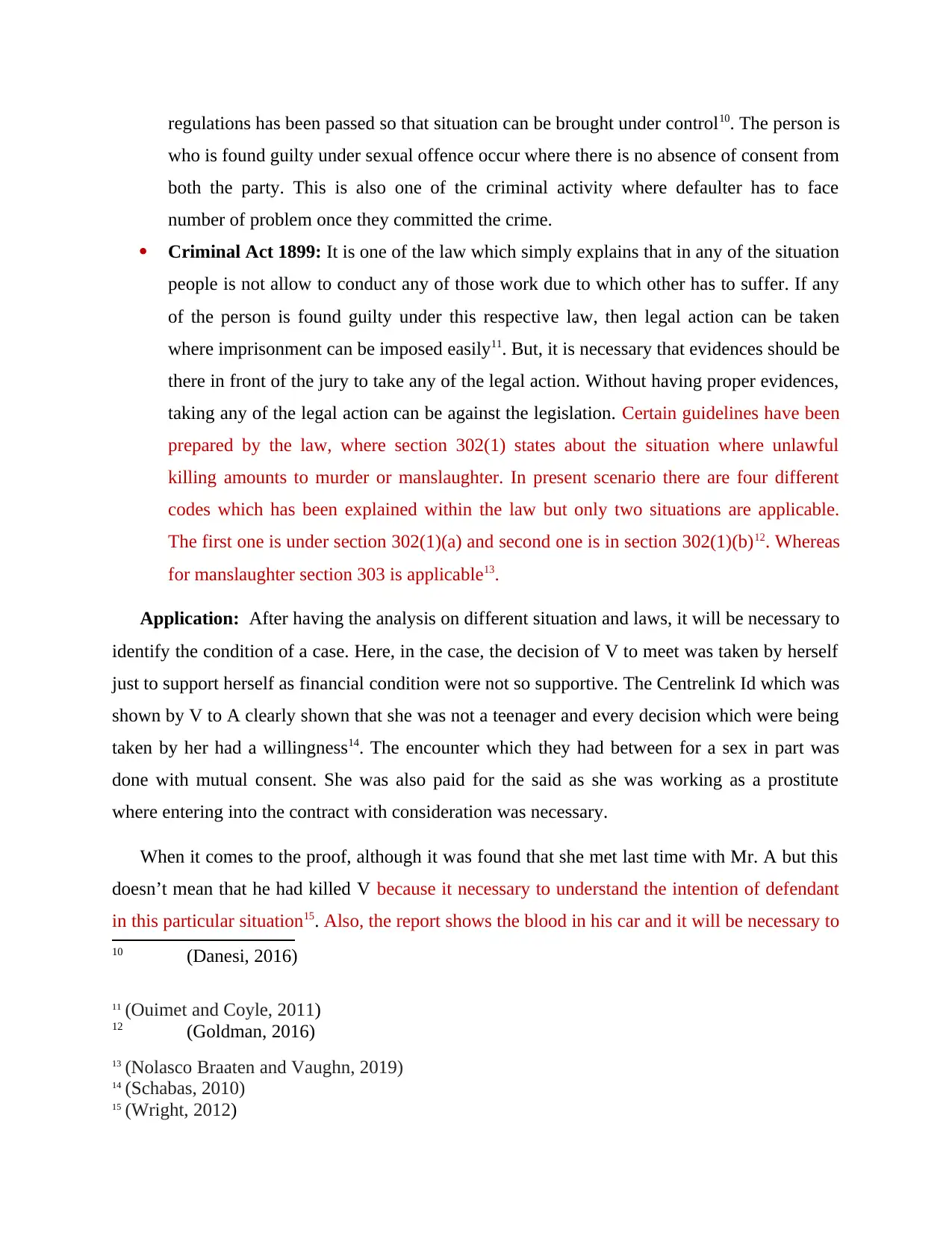
regulations has been passed so that situation can be brought under control10. The person is
who is found guilty under sexual offence occur where there is no absence of consent from
both the party. This is also one of the criminal activity where defaulter has to face
number of problem once they committed the crime.
Criminal Act 1899: It is one of the law which simply explains that in any of the situation
people is not allow to conduct any of those work due to which other has to suffer. If any
of the person is found guilty under this respective law, then legal action can be taken
where imprisonment can be imposed easily11. But, it is necessary that evidences should be
there in front of the jury to take any of the legal action. Without having proper evidences,
taking any of the legal action can be against the legislation. Certain guidelines have been
prepared by the law, where section 302(1) states about the situation where unlawful
killing amounts to murder or manslaughter. In present scenario there are four different
codes which has been explained within the law but only two situations are applicable.
The first one is under section 302(1)(a) and second one is in section 302(1)(b)12. Whereas
for manslaughter section 303 is applicable13.
Application: After having the analysis on different situation and laws, it will be necessary to
identify the condition of a case. Here, in the case, the decision of V to meet was taken by herself
just to support herself as financial condition were not so supportive. The Centrelink Id which was
shown by V to A clearly shown that she was not a teenager and every decision which were being
taken by her had a willingness14. The encounter which they had between for a sex in part was
done with mutual consent. She was also paid for the said as she was working as a prostitute
where entering into the contract with consideration was necessary.
When it comes to the proof, although it was found that she met last time with Mr. A but this
doesn’t mean that he had killed V because it necessary to understand the intention of defendant
in this particular situation15. Also, the report shows the blood in his car and it will be necessary to
10 (Danesi, 2016)
11 (Ouimet and Coyle, 2011)
12 (Goldman, 2016)
13 (Nolasco Braaten and Vaughn, 2019)
14 (Schabas, 2010)
15 (Wright, 2012)
who is found guilty under sexual offence occur where there is no absence of consent from
both the party. This is also one of the criminal activity where defaulter has to face
number of problem once they committed the crime.
Criminal Act 1899: It is one of the law which simply explains that in any of the situation
people is not allow to conduct any of those work due to which other has to suffer. If any
of the person is found guilty under this respective law, then legal action can be taken
where imprisonment can be imposed easily11. But, it is necessary that evidences should be
there in front of the jury to take any of the legal action. Without having proper evidences,
taking any of the legal action can be against the legislation. Certain guidelines have been
prepared by the law, where section 302(1) states about the situation where unlawful
killing amounts to murder or manslaughter. In present scenario there are four different
codes which has been explained within the law but only two situations are applicable.
The first one is under section 302(1)(a) and second one is in section 302(1)(b)12. Whereas
for manslaughter section 303 is applicable13.
Application: After having the analysis on different situation and laws, it will be necessary to
identify the condition of a case. Here, in the case, the decision of V to meet was taken by herself
just to support herself as financial condition were not so supportive. The Centrelink Id which was
shown by V to A clearly shown that she was not a teenager and every decision which were being
taken by her had a willingness14. The encounter which they had between for a sex in part was
done with mutual consent. She was also paid for the said as she was working as a prostitute
where entering into the contract with consideration was necessary.
When it comes to the proof, although it was found that she met last time with Mr. A but this
doesn’t mean that he had killed V because it necessary to understand the intention of defendant
in this particular situation15. Also, the report shows the blood in his car and it will be necessary to
10 (Danesi, 2016)
11 (Ouimet and Coyle, 2011)
12 (Goldman, 2016)
13 (Nolasco Braaten and Vaughn, 2019)
14 (Schabas, 2010)
15 (Wright, 2012)
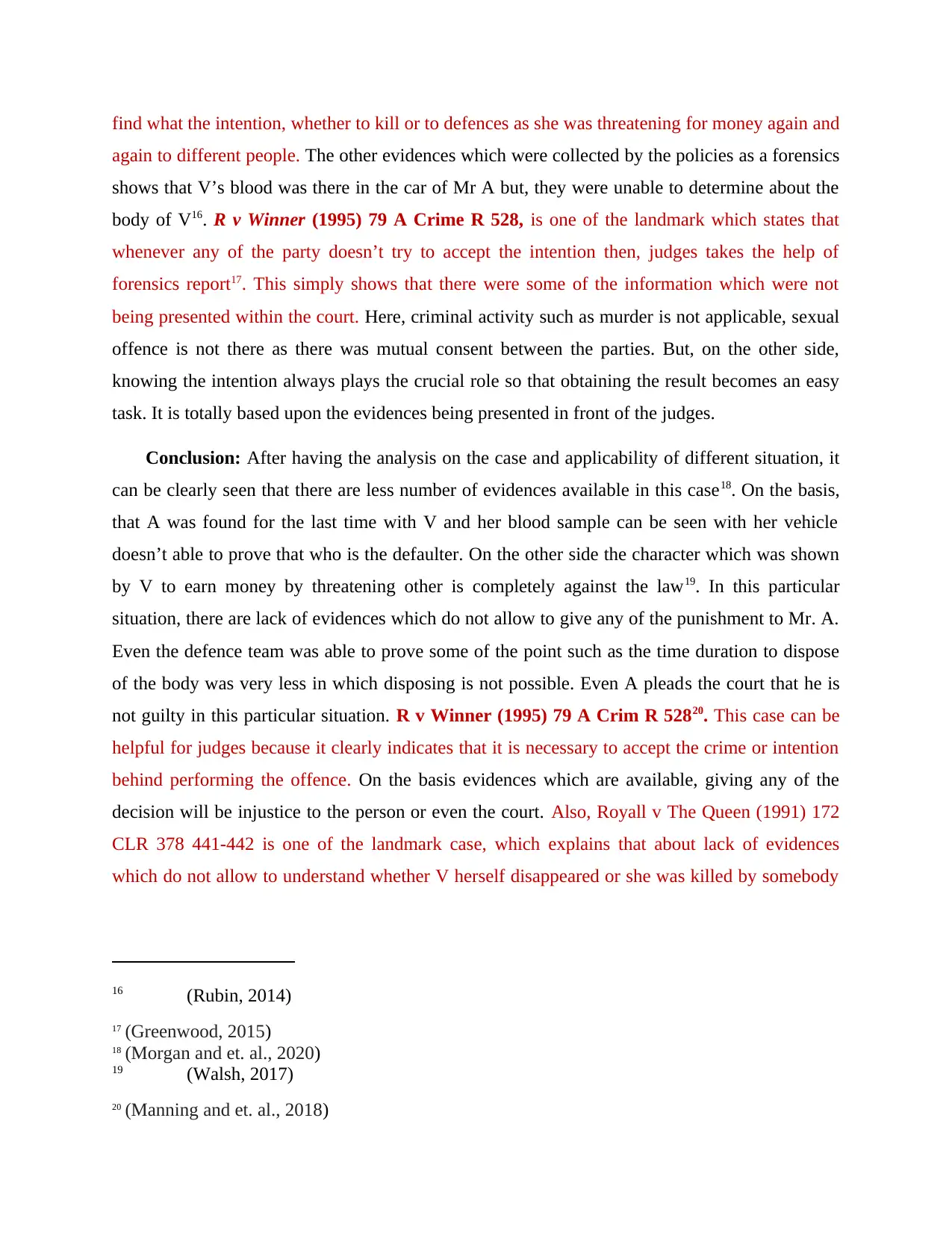
find what the intention, whether to kill or to defences as she was threatening for money again and
again to different people. The other evidences which were collected by the policies as a forensics
shows that V’s blood was there in the car of Mr A but, they were unable to determine about the
body of V16. R v Winner (1995) 79 A Crime R 528, is one of the landmark which states that
whenever any of the party doesn’t try to accept the intention then, judges takes the help of
forensics report17. This simply shows that there were some of the information which were not
being presented within the court. Here, criminal activity such as murder is not applicable, sexual
offence is not there as there was mutual consent between the parties. But, on the other side,
knowing the intention always plays the crucial role so that obtaining the result becomes an easy
task. It is totally based upon the evidences being presented in front of the judges.
Conclusion: After having the analysis on the case and applicability of different situation, it
can be clearly seen that there are less number of evidences available in this case18. On the basis,
that A was found for the last time with V and her blood sample can be seen with her vehicle
doesn’t able to prove that who is the defaulter. On the other side the character which was shown
by V to earn money by threatening other is completely against the law19. In this particular
situation, there are lack of evidences which do not allow to give any of the punishment to Mr. A.
Even the defence team was able to prove some of the point such as the time duration to dispose
of the body was very less in which disposing is not possible. Even A pleads the court that he is
not guilty in this particular situation. R v Winner (1995) 79 A Crim R 52820. This case can be
helpful for judges because it clearly indicates that it is necessary to accept the crime or intention
behind performing the offence. On the basis evidences which are available, giving any of the
decision will be injustice to the person or even the court. Also, Royall v The Queen (1991) 172
CLR 378 441-442 is one of the landmark case, which explains that about lack of evidences
which do not allow to understand whether V herself disappeared or she was killed by somebody
16 (Rubin, 2014)
17 (Greenwood, 2015)
18 (Morgan and et. al., 2020)
19 (Walsh, 2017)
20 (Manning and et. al., 2018)
again to different people. The other evidences which were collected by the policies as a forensics
shows that V’s blood was there in the car of Mr A but, they were unable to determine about the
body of V16. R v Winner (1995) 79 A Crime R 528, is one of the landmark which states that
whenever any of the party doesn’t try to accept the intention then, judges takes the help of
forensics report17. This simply shows that there were some of the information which were not
being presented within the court. Here, criminal activity such as murder is not applicable, sexual
offence is not there as there was mutual consent between the parties. But, on the other side,
knowing the intention always plays the crucial role so that obtaining the result becomes an easy
task. It is totally based upon the evidences being presented in front of the judges.
Conclusion: After having the analysis on the case and applicability of different situation, it
can be clearly seen that there are less number of evidences available in this case18. On the basis,
that A was found for the last time with V and her blood sample can be seen with her vehicle
doesn’t able to prove that who is the defaulter. On the other side the character which was shown
by V to earn money by threatening other is completely against the law19. In this particular
situation, there are lack of evidences which do not allow to give any of the punishment to Mr. A.
Even the defence team was able to prove some of the point such as the time duration to dispose
of the body was very less in which disposing is not possible. Even A pleads the court that he is
not guilty in this particular situation. R v Winner (1995) 79 A Crim R 52820. This case can be
helpful for judges because it clearly indicates that it is necessary to accept the crime or intention
behind performing the offence. On the basis evidences which are available, giving any of the
decision will be injustice to the person or even the court. Also, Royall v The Queen (1991) 172
CLR 378 441-442 is one of the landmark case, which explains that about lack of evidences
which do not allow to understand whether V herself disappeared or she was killed by somebody
16 (Rubin, 2014)
17 (Greenwood, 2015)
18 (Morgan and et. al., 2020)
19 (Walsh, 2017)
20 (Manning and et. al., 2018)
⊘ This is a preview!⊘
Do you want full access?
Subscribe today to unlock all pages.

Trusted by 1+ million students worldwide
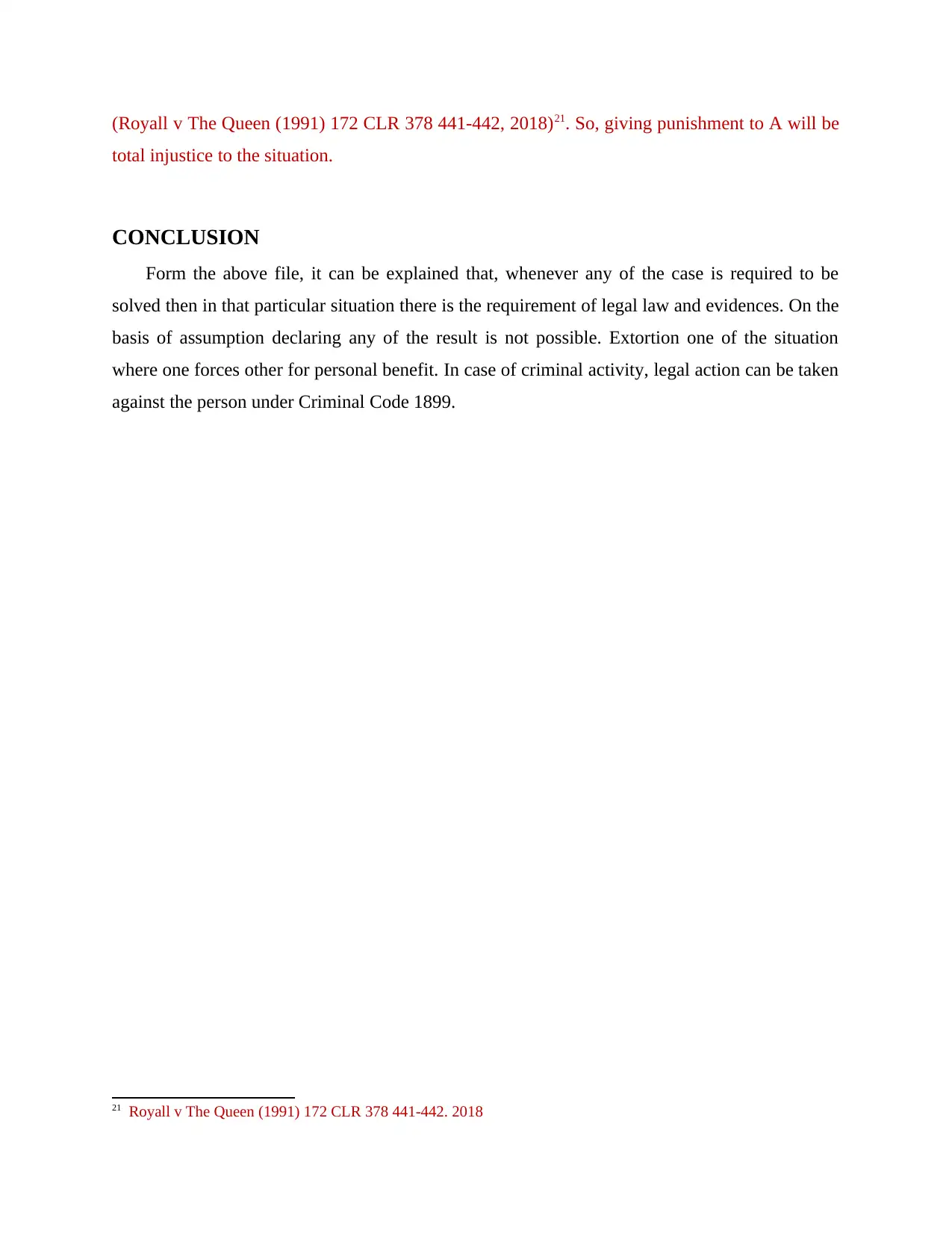
(Royall v The Queen (1991) 172 CLR 378 441-442, 2018)21. So, giving punishment to A will be
total injustice to the situation.
CONCLUSION
Form the above file, it can be explained that, whenever any of the case is required to be
solved then in that particular situation there is the requirement of legal law and evidences. On the
basis of assumption declaring any of the result is not possible. Extortion one of the situation
where one forces other for personal benefit. In case of criminal activity, legal action can be taken
against the person under Criminal Code 1899.
21 Royall v The Queen (1991) 172 CLR 378 441-442. 2018
total injustice to the situation.
CONCLUSION
Form the above file, it can be explained that, whenever any of the case is required to be
solved then in that particular situation there is the requirement of legal law and evidences. On the
basis of assumption declaring any of the result is not possible. Extortion one of the situation
where one forces other for personal benefit. In case of criminal activity, legal action can be taken
against the person under Criminal Code 1899.
21 Royall v The Queen (1991) 172 CLR 378 441-442. 2018
Paraphrase This Document
Need a fresh take? Get an instant paraphrase of this document with our AI Paraphraser
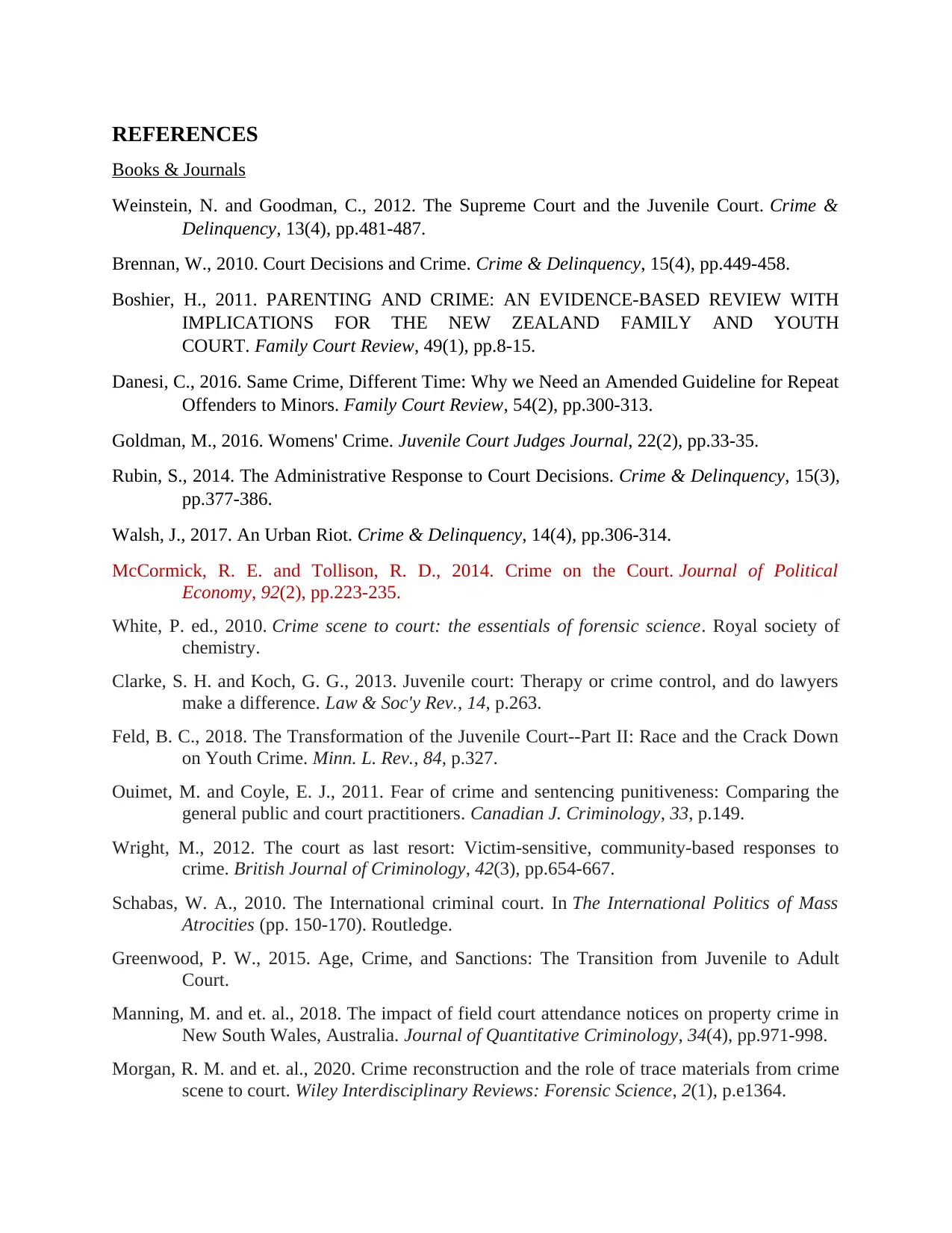
REFERENCES
Books & Journals
Weinstein, N. and Goodman, C., 2012. The Supreme Court and the Juvenile Court. Crime &
Delinquency, 13(4), pp.481-487.
Brennan, W., 2010. Court Decisions and Crime. Crime & Delinquency, 15(4), pp.449-458.
Boshier, H., 2011. PARENTING AND CRIME: AN EVIDENCE-BASED REVIEW WITH
IMPLICATIONS FOR THE NEW ZEALAND FAMILY AND YOUTH
COURT. Family Court Review, 49(1), pp.8-15.
Danesi, C., 2016. Same Crime, Different Time: Why we Need an Amended Guideline for Repeat
Offenders to Minors. Family Court Review, 54(2), pp.300-313.
Goldman, M., 2016. Womens' Crime. Juvenile Court Judges Journal, 22(2), pp.33-35.
Rubin, S., 2014. The Administrative Response to Court Decisions. Crime & Delinquency, 15(3),
pp.377-386.
Walsh, J., 2017. An Urban Riot. Crime & Delinquency, 14(4), pp.306-314.
McCormick, R. E. and Tollison, R. D., 2014. Crime on the Court. Journal of Political
Economy, 92(2), pp.223-235.
White, P. ed., 2010. Crime scene to court: the essentials of forensic science. Royal society of
chemistry.
Clarke, S. H. and Koch, G. G., 2013. Juvenile court: Therapy or crime control, and do lawyers
make a difference. Law & Soc'y Rev., 14, p.263.
Feld, B. C., 2018. The Transformation of the Juvenile Court--Part II: Race and the Crack Down
on Youth Crime. Minn. L. Rev., 84, p.327.
Ouimet, M. and Coyle, E. J., 2011. Fear of crime and sentencing punitiveness: Comparing the
general public and court practitioners. Canadian J. Criminology, 33, p.149.
Wright, M., 2012. The court as last resort: Victim‐sensitive, community‐based responses to
crime. British Journal of Criminology, 42(3), pp.654-667.
Schabas, W. A., 2010. The International criminal court. In The International Politics of Mass
Atrocities (pp. 150-170). Routledge.
Greenwood, P. W., 2015. Age, Crime, and Sanctions: The Transition from Juvenile to Adult
Court.
Manning, M. and et. al., 2018. The impact of field court attendance notices on property crime in
New South Wales, Australia. Journal of Quantitative Criminology, 34(4), pp.971-998.
Morgan, R. M. and et. al., 2020. Crime reconstruction and the role of trace materials from crime
scene to court. Wiley Interdisciplinary Reviews: Forensic Science, 2(1), p.e1364.
Books & Journals
Weinstein, N. and Goodman, C., 2012. The Supreme Court and the Juvenile Court. Crime &
Delinquency, 13(4), pp.481-487.
Brennan, W., 2010. Court Decisions and Crime. Crime & Delinquency, 15(4), pp.449-458.
Boshier, H., 2011. PARENTING AND CRIME: AN EVIDENCE-BASED REVIEW WITH
IMPLICATIONS FOR THE NEW ZEALAND FAMILY AND YOUTH
COURT. Family Court Review, 49(1), pp.8-15.
Danesi, C., 2016. Same Crime, Different Time: Why we Need an Amended Guideline for Repeat
Offenders to Minors. Family Court Review, 54(2), pp.300-313.
Goldman, M., 2016. Womens' Crime. Juvenile Court Judges Journal, 22(2), pp.33-35.
Rubin, S., 2014. The Administrative Response to Court Decisions. Crime & Delinquency, 15(3),
pp.377-386.
Walsh, J., 2017. An Urban Riot. Crime & Delinquency, 14(4), pp.306-314.
McCormick, R. E. and Tollison, R. D., 2014. Crime on the Court. Journal of Political
Economy, 92(2), pp.223-235.
White, P. ed., 2010. Crime scene to court: the essentials of forensic science. Royal society of
chemistry.
Clarke, S. H. and Koch, G. G., 2013. Juvenile court: Therapy or crime control, and do lawyers
make a difference. Law & Soc'y Rev., 14, p.263.
Feld, B. C., 2018. The Transformation of the Juvenile Court--Part II: Race and the Crack Down
on Youth Crime. Minn. L. Rev., 84, p.327.
Ouimet, M. and Coyle, E. J., 2011. Fear of crime and sentencing punitiveness: Comparing the
general public and court practitioners. Canadian J. Criminology, 33, p.149.
Wright, M., 2012. The court as last resort: Victim‐sensitive, community‐based responses to
crime. British Journal of Criminology, 42(3), pp.654-667.
Schabas, W. A., 2010. The International criminal court. In The International Politics of Mass
Atrocities (pp. 150-170). Routledge.
Greenwood, P. W., 2015. Age, Crime, and Sanctions: The Transition from Juvenile to Adult
Court.
Manning, M. and et. al., 2018. The impact of field court attendance notices on property crime in
New South Wales, Australia. Journal of Quantitative Criminology, 34(4), pp.971-998.
Morgan, R. M. and et. al., 2020. Crime reconstruction and the role of trace materials from crime
scene to court. Wiley Interdisciplinary Reviews: Forensic Science, 2(1), p.e1364.
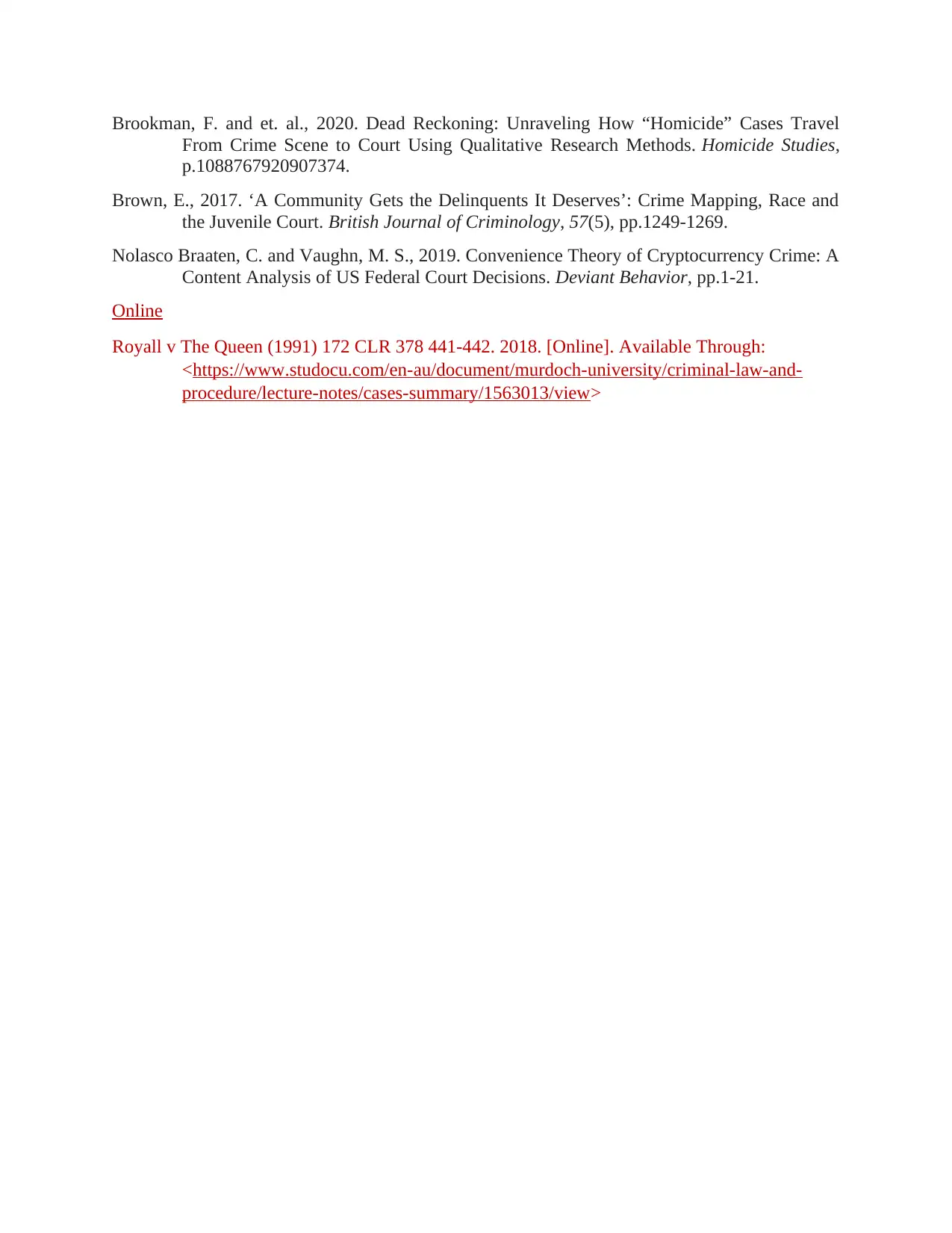
Brookman, F. and et. al., 2020. Dead Reckoning: Unraveling How “Homicide” Cases Travel
From Crime Scene to Court Using Qualitative Research Methods. Homicide Studies,
p.1088767920907374.
Brown, E., 2017. ‘A Community Gets the Delinquents It Deserves’: Crime Mapping, Race and
the Juvenile Court. British Journal of Criminology, 57(5), pp.1249-1269.
Nolasco Braaten, C. and Vaughn, M. S., 2019. Convenience Theory of Cryptocurrency Crime: A
Content Analysis of US Federal Court Decisions. Deviant Behavior, pp.1-21.
Online
Royall v The Queen (1991) 172 CLR 378 441-442. 2018. [Online]. Available Through:
<https://www.studocu.com/en-au/document/murdoch-university/criminal-law-and-
procedure/lecture-notes/cases-summary/1563013/view>
From Crime Scene to Court Using Qualitative Research Methods. Homicide Studies,
p.1088767920907374.
Brown, E., 2017. ‘A Community Gets the Delinquents It Deserves’: Crime Mapping, Race and
the Juvenile Court. British Journal of Criminology, 57(5), pp.1249-1269.
Nolasco Braaten, C. and Vaughn, M. S., 2019. Convenience Theory of Cryptocurrency Crime: A
Content Analysis of US Federal Court Decisions. Deviant Behavior, pp.1-21.
Online
Royall v The Queen (1991) 172 CLR 378 441-442. 2018. [Online]. Available Through:
<https://www.studocu.com/en-au/document/murdoch-university/criminal-law-and-
procedure/lecture-notes/cases-summary/1563013/view>
⊘ This is a preview!⊘
Do you want full access?
Subscribe today to unlock all pages.

Trusted by 1+ million students worldwide
1 out of 9
Related Documents
Your All-in-One AI-Powered Toolkit for Academic Success.
+13062052269
info@desklib.com
Available 24*7 on WhatsApp / Email
![[object Object]](/_next/static/media/star-bottom.7253800d.svg)
Unlock your academic potential
Copyright © 2020–2025 A2Z Services. All Rights Reserved. Developed and managed by ZUCOL.





